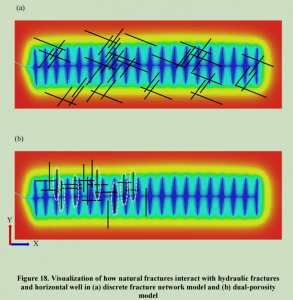CO2 EOR SIMULATION IN UNCONVENTIONAL LIQUID RESERVOIRS: AN EAGLE FORD CASE STUDY
本研究的目的是提出一种改进方法,以优化非常规液体储层中不同CO2提高石油采收率(EOR)过程,特别是在鹰福特页岩的挥发性油区域。本研究中的双孔隙、结构化网格模型将与实地收集的实际数据进行历史匹配,以确保CO2 EOR研究结果的意义。以往的非常规液体储层CO2 EOR模拟研究没有在全场规模上进行,也没有在应用CO2 EOR模型之前进行历史匹配。没有历史匹配步骤,模拟可能会在CO2 EOR研究中产生误导性结果。此外,我们正在实施双孔隙模式的模拟,以考虑在鹰福特露头上观察到的自然裂缝的存在。
CMG软件的应用情况
研究中使用了CMG的GEM组成模拟器来模拟双孔隙结构化网格模型。GEM能够处理多达10个组分的化学品,可以指定反应速率和化学计量数来描述凝胶化过程。研究中还使用了CMG的CMOST辅助历史匹配工具,进行了数百次运行,以找到与实际油率最匹配的模型参数。此外,研究中还使用了CMG软件包中的其他工具,如WINPROP流体建模工具,对流体模型进行回归处理,以及用于模拟凝胶吸附和运输的影响。

ABSTRACT
The purpose of this work is to perform an improved method to optimize different CO2 Enhanced Oil Recovery (EOR) processes in unconventional liquid reservoirs, particularly in the volatile oil region of the Eagle Ford shale. The dual-porosity, structured grid model in this research will be history matched with actual data collected from the field to ensure the results of CO2 EOR study to be meaningful. Previous simulation studies of CO2 EOR in the unconventional liquid reservoirs were not done in full field-scale and were not history matched before applying CO2 EOR to the model. Without history matching step, the simulation might generate misleading results in CO2 EOR studies. In addition, we are implementing the simulation in the dual-porosity mode to account for the presence of natural fractures which have been observed on Eagle Ford outcrop.
This research provides comprehensive sensitivity analyses of important parameters in both matrix and natural fracture systems of the dual-porosity model. The history matched model suggests that matrix porosity in the volatile oil region of Eagle Ford shale might be overestimated in many previous investigations. Also, sensitivity analysis shows that the natural fracture permeability perpendicular to the direction of the horizontal well has a significant impact on oil rates in numerical simulation.
Different injection schemes were considered as performed in CO2 EOR in conventional floods. WAG (water alternating gas) and continuous injection were both tested to provide the basic output performance in order to calibrate economic models. Among different CO2 EOR methods tested in this research, huff-n-puff yields the most promising outcome as compared to continuous injection in both oil production and economic performance in the volatile oil region of the Eagle Ford shale.
Simulator: GEM
作者单位
作者Tuan Thanh Phi向德克萨斯A&M大学研究生与专业研究办公室提交了这篇论文,作为部分满足石油工程硕士学位要求的工作。论文完成于2016年8月,导师为David S. Schechter教授,委员会成员包括Berna Hascakir和Frederick M. Chester,系主任为A. Daniel Hill。

